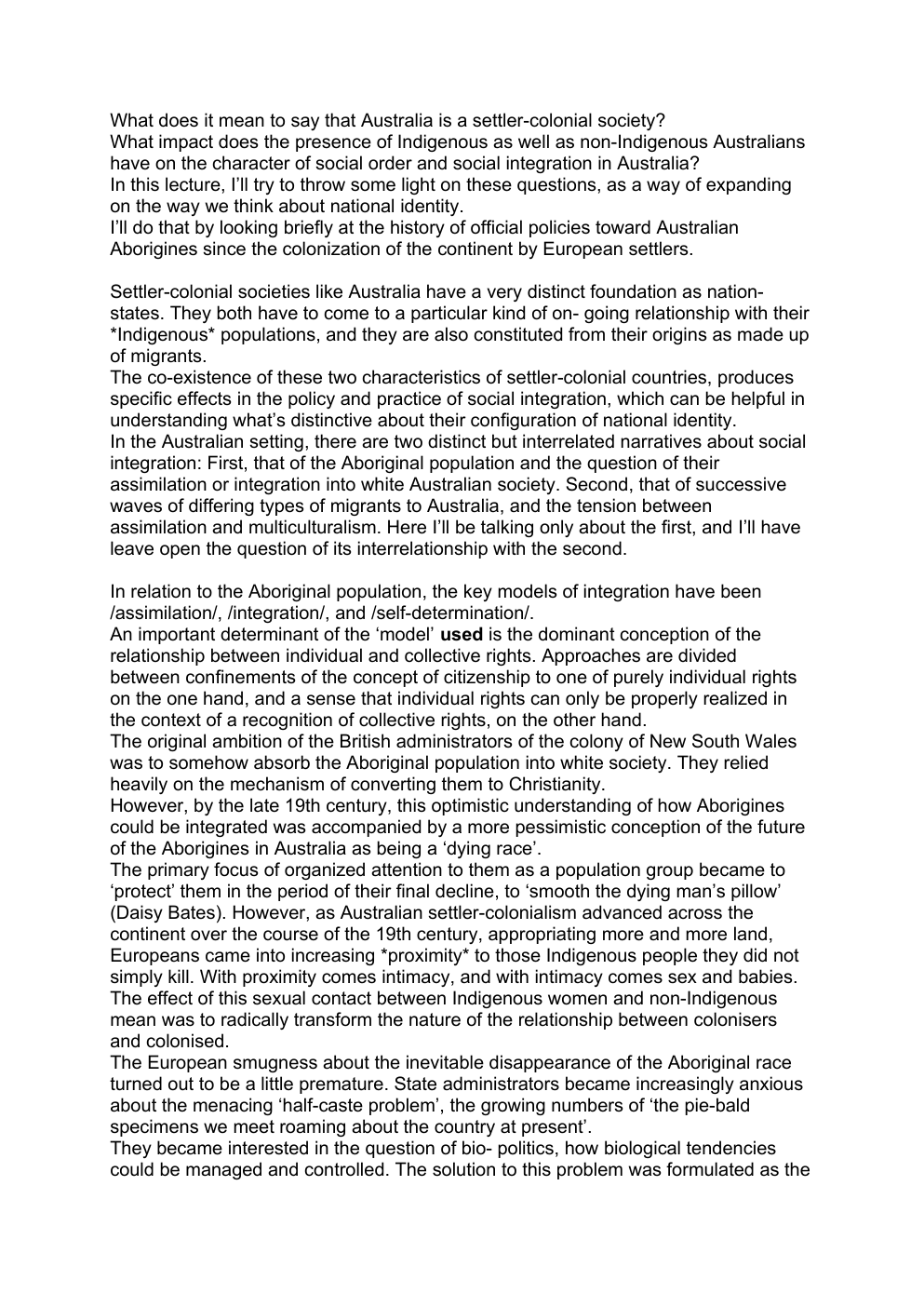australia's aboriginal problem
Publié le 26/05/2022

Extrait du document
«
What does it mean to say that Australia is a settler-colonial society?
What impact does the presence of Indigenous as well as non-Indigenous Australians
have on the character of social order and social integration in Australia?
In this lecture, I’ll try to throw some light on these questions, as a way of expanding
on the way we think about national identity.
I’ll do that by looking briefly at the history of official policies toward Australian
Aborigines since the colonization of the continent by European settlers.
Settler-colonial societies like Australia have a very distinct foundation as nationstates.
They both have to come to a particular kind of on- going relationship with their
*Indigenous* populations, and they are also constituted from their origins as made up
of migrants.
The co-existence of these two characteristics of settler-colonial countries, produces
specific effects in the policy and practice of social integration, which can be helpful in
understanding what’s distinctive about their configuration of national identity.
In the Australian setting, there are two distinct but interrelated narratives about social
integration: First, that of the Aboriginal population and the question of their
assimilation or integration into white Australian society.
Second, that of successive
waves of differing types of migrants to Australia, and the tension between
assimilation and multiculturalism.
Here I’ll be talking only about the first, and I’ll have
leave open the question of its interrelationship with the second.
In relation to the Aboriginal population, the key models of integration have been
/assimilation/, /integration/, and /self-determination/.
An important determinant of the ‘model’ used is the dominant conception of the
relationship between individual and collective rights.
Approaches are divided
between confinements of the concept of citizenship to one of purely individual rights
on the one hand, and a sense that individual rights can only be properly realized in
the context of a recognition of collective rights, on the other hand.
The original ambition of the British administrators of the colony of New South Wales
was to somehow absorb the Aboriginal population into white society.
They relied
heavily on the mechanism of converting them to Christianity.
However, by the late 19th century, this optimistic understanding of how Aborigines
could be integrated was accompanied by a more pessimistic conception of the future
of the Aborigines in Australia as being a ‘dying race’.
The primary focus of organized attention to them as a population group became to
‘protect’ them in the period of their final decline, to ‘smooth the dying man’s pillow’
(Daisy Bates).
However, as Australian settler-colonialism advanced across the
continent over the course of the 19th century, appropriating more and more land,
Europeans came into increasing *proximity* to those Indigenous people they did not
simply kill.
With proximity comes intimacy, and with intimacy comes sex and babies.
The effect of this sexual contact between Indigenous women and non-Indigenous
mean was to radically transform the nature of the relationship between colonisers
and colonised.
The European smugness about the inevitable disappearance of the Aboriginal race
turned out to be a little premature.
State administrators became increasingly anxious
about the menacing ‘half-caste problem’, the growing numbers of ‘the pie-bald
specimens we meet roaming about the country at present’.
They became interested in the question of bio- politics, how biological tendencies
could be managed and controlled.
The solution to this problem was formulated as the.
»
↓↓↓ APERÇU DU DOCUMENT ↓↓↓
Liens utiles
- HDA : the problem we all live with
- The problem we all lives with
- Miembros de Naciones Unidas Afganistán Etiopía Nepal Albania Islas Fiji Nicaragua Alemania Filipinas Níger Andorra Finlandia Nigeria Angola Francia Noruega Antigua y Barbuda Gabón Nueva Zelanda Arabia Saudí Gambia Omán Argelia Georgia Países Bajos Argentina Ghana Pakistán Armenia Granada Palau Australia Grecia Panamá Austria Guatemala Papúa-Nueva
- Miembros de la Commonwealth ESTADOS FECHA DE INGRESO Antigua y Barbuda (1981) Australia (1931) Bahamas (1973) Bangladesh (1972) Barbados (1966) Belice (1981) Botsuana (1966) Brunei (1984) Camerún (1995) Canadá (1931) Chipre (1961) Dominica (1978) Gambia (1965) Ghana (1957) Granada (1974) Guyana (1966) India (1947) Islas Fiji (se reincorporó
- Las islas más grandes del mundo ISLA SUPERFICIE (en km2) Australia* 7.


